First aid can sound scary, but it’s much easier than you think – and it could save a life.
Here’s how to resuscitate a baby, and deal with fever and burns
At a glance
- Call for help, and work as quickly and calmly as you can
- If they’re breathing but unconscious, you need to put them in the recovery position
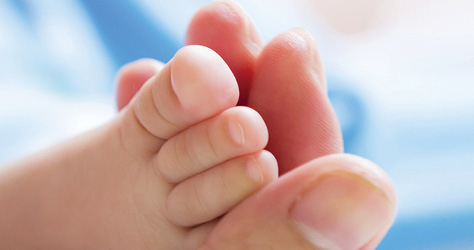
What to do in an emergency
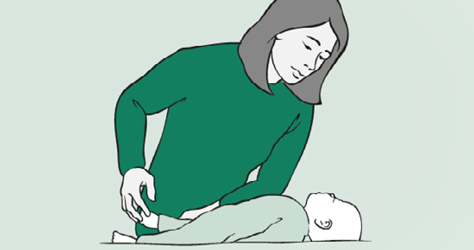
- Call for help, and work as quickly and calmly as you can
- Is your baby conscious? Call their name and tap them gently on the sole of their foot. Don’t shake a baby. If there is no response, you need to check if they’re breathing
- To do that, place one hand on their forehead and gently tilt their head back. Use a finger of the other hand to tilt the chin upwards, then put your cheek/ear near their mouth. Listen and feel for breaths. Allow 10 seconds for this
- If they’re not breathing, start resuscitation straight away. If there’s someone with you, get them to call an ambulance by dialling 999. If you’re on your own, do one minute of resuscitation then take your baby with you to dial 999
- If they are breathing but unconscious, put them in the recovery position and dial 999
Resuscitation for babies 0-12 months
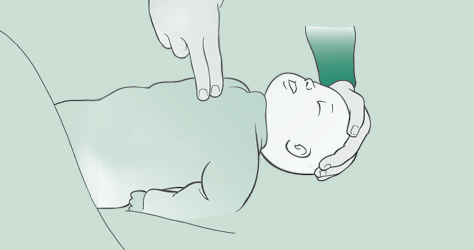
(For children over one, click here)
Take a breath and place your lips over their mouth and nose. Blow gently for one second – long enough for you to see their chest rise.
Take your mouth away and their chest should fall. Do five of these rescue breaths.
Then do 30 chest compressions: place two fingers on the center of the baby’s chest right on the breastbone, then press down to a depth of one third of the baby’s chest. Do this 30 times quite quickly – about two per second (that’s the speed of the Bee Gees’ song Staying Alive). Keep the other hand on the baby’s head to tilt it slightly upwards.
Then give two more rescue breaths and repeat the cycle of 30 compressions, followed by two rescue breaths until help arrives or the baby responds by regaining consciousness.
Recovery position for babies
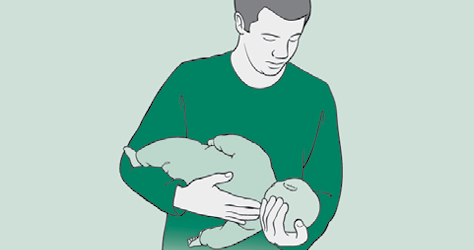
If they’re breathing but unconscious, you need to put them in the recovery position. Cradle the baby in your arms with their head tilted downwards.
Monitor and record the level of response, pulse and breathing until help arrives.
How to deal with...
Choking (babies 0-12 months)
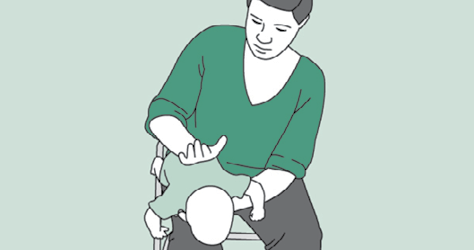 If you can see the object try to remove it but don’t poke as it might push the object further down and make it harder to remove.
If you can see the object try to remove it but don’t poke as it might push the object further down and make it harder to remove.
You can tell when a baby is choking as they will be unable to cry, cough, make any noise or breathe. To help a baby who is choking you should:
-
Slap it out. Lay baby face down on your thigh supporting their head with your hand and with their head lower than their bottom. Give up to five back blows firmly on their back with the heel of one hand between their shoulder blades.
- If back blows do not dislodge the blockage, turn the baby over so they are facing upwards and give up to five chest thrusts: Place two fingers in the middle of their chest just below the nipples. Push sharply downwards up to five times.
- Call 999 if the blockage does not dislodge. And while you wait for the ambulance, continue with cycles of back blows and chest thrusts until the blockage dislodges, help arrives or the baby becomes unresponsive.
Fever
A high temperature (fever) is the body’s way of fighting off infection. In babies and children a fever is counted as above 38C (100.4F). A very high temperature can trigger a seizure (febrile convulsion), so it’s important to bring it down quickly.
Use the correct dose of a children’s formula of either paracetamol or ibuprofen. Don’t overdose. You can also cool them down by taking off some clothes and sponging them with tepid (not cold) water. If you have a fan, use that too. Call the doctor or go to A&E if you are worried or unable to bring down a temperature.
If your child has a febrile convulsion, their body will go stiff, they will lose consciousness and their legs and arms may twitch. Put them in the recovery position immediately (see above) to keep their airway open. If it’s their first seizure or it lasts more than five minutes, take them to hospital or dial 999. Febrile convulsions are alarming to watch but are rarely dangerous and don’t have long-term effects.
Burns
Put your baby’s burn under cold running water for at least 10 minutes to cool it down and reduce pain. It will seem like a long time, but 10 minutes is the minimum.
Burns can swell, so take off any tight clothes.
Once it’s cool, cover the burn loosely with cling film or a plastic bag to prevent infection.
Take your baby to A&E to be checked out.
Meningitis
Not all children experience every symptom of this disease, which can develop rapidly. Early signs are: a high temperature and stiff joints, cold hands and feet, mottled or pale skin and sleepiness. Babies may be drowsy and/or may cry in a high-pitched, whimpering tone, yet not want to be touched.
The classic sign of meningitis is a rash – red or purple spots that don’t disappear if you roll a glass over them. But this is one of the last symptoms to appear because it shows the disease has progressed to septicaemia (blood poisoning).
Not every person will get a rash, as not everyone gets septicaemia. If you suspect meningitis, don’t wait for a rash: call 999 or drive your child to A&E immediately. While waiting for help, keep your child cool and treat their high temperature with paracetamol or ibuprofen.